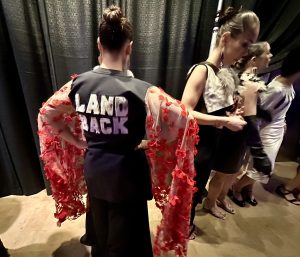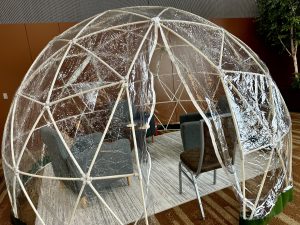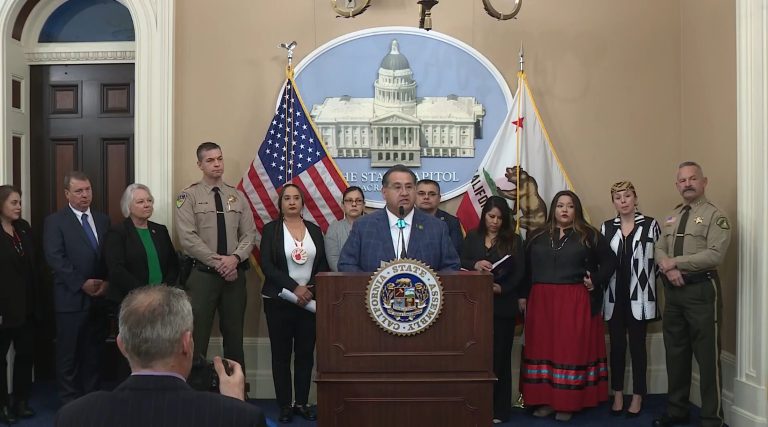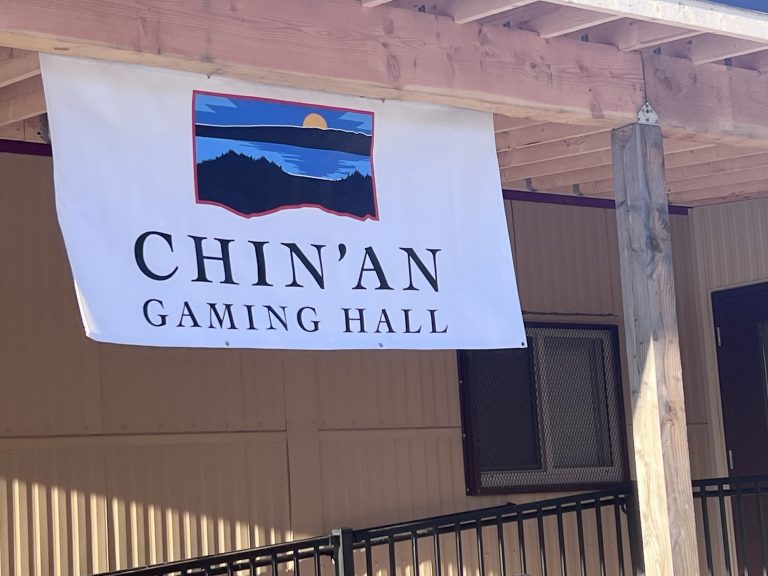Podcast: Play in new window | Download | Embed
In January 2023, a catastrophic fire destroyed the generator and a backup source of power for Newtok’s school. The charred remains are housed inside a metal container behind the main school building. (Photo: Emily Schwing / KYUK)
A group of Alaska Native mothers from the village of Newtok reported on deteriorating conditions in their community at the annual Arctic Encounter Symposium in Anchorage last week.
As Emily Schwing reports, climate change means the permafrost under the Alaska Native community is deteriorating and causing severe erosion.
The village has been trying to relocate for more than three decades.
The five women took to the stage barefoot, in solidarity for their friends and family members who live in Newtok.
For many years, the village has been working with several state and federal agencies to relocate the entire community – nearly 400 people – to higher, more stable ground at Mertarvik. It’s nine miles across the Ninglick River.
Carolyn George is a Newtok Village Council member.
“There is no blueprint on how to do this relocation. Relocating the whole community to a whole different place and, we did not know how to do it and it’s been taking too long.”
There are neatly 150 communities in Alaska considering partial and full relocations due to climate change driven environmental disasters.
Jackie Schaeffer is the Director of Climate Initiatives at the Alaska Native Tribal Health Consortium.
Schaeffer says lessons from Newtok and Mertarvik can inform those future projects.
“This is just one community of many that will need to be relocated in the state of Alaska and if we can’t figure it out for a community of 400 people there’s no way when we hit Louisiana, la and all the other lower 48 communities, that we’re gonna be able to figure it out.”
In the meantime, she says the mothers of Newtok are an inspiration.
“They’re going to adapt.”
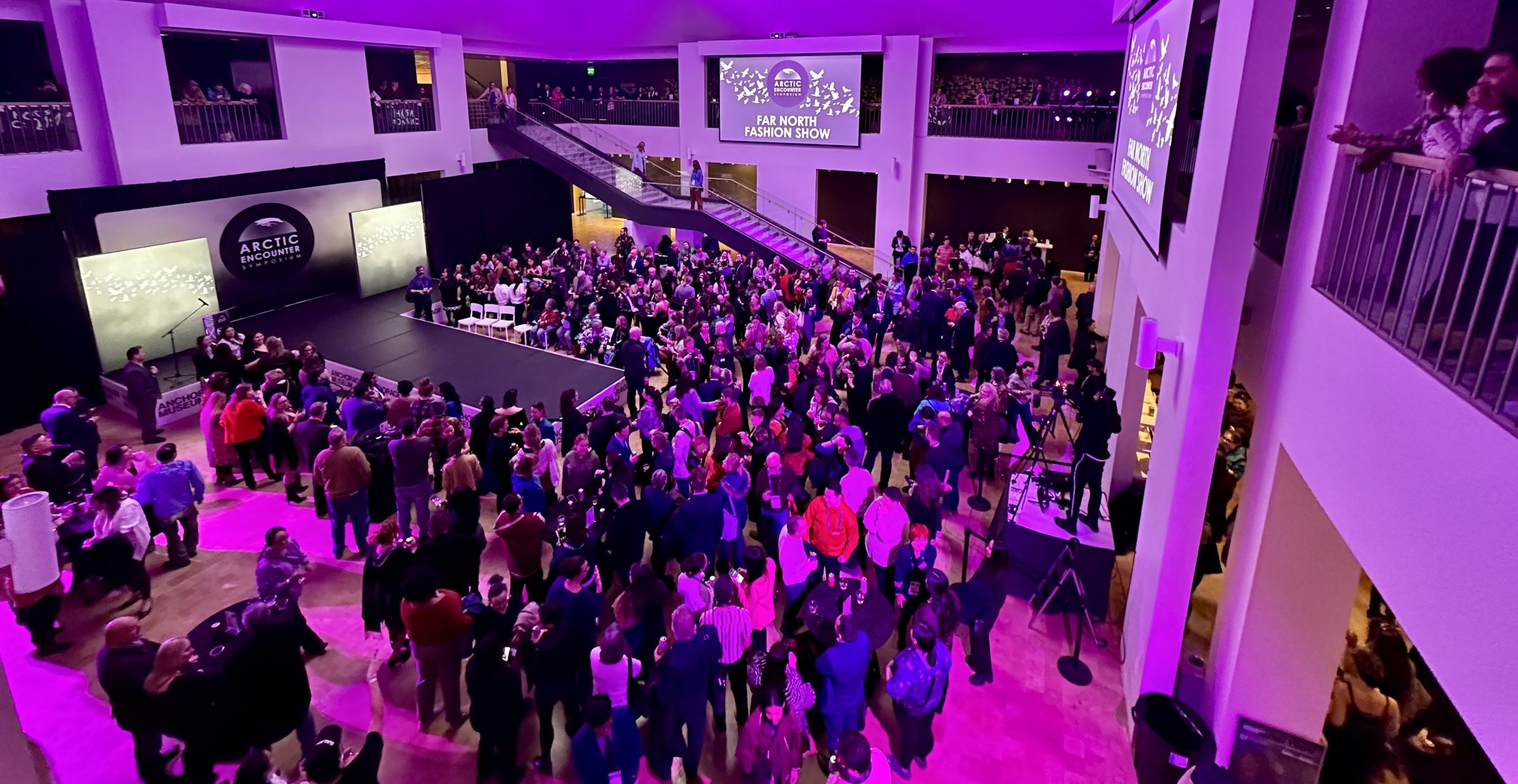
Photo: Antonia Gonzales / National Native News
Digital Exclusive: The last day of the Arctic Encounter Symposium Friday ended with a discussion about emergency preparedness and disaster contingency.
Jill Fratis from our flagship station KNBA has more.
The panel of five included Dr. Dimitri Kusnezov, Under Secretary for Science and Technology at the Department of Homeland Security (DHS); Irish Ambassador to the U.S. Geraldine Byrne Nason; and Melanie Bahnke, President & CEO of Kawerak, Inc.
After hearing the plans the Federal Emergency Management Agency (FEMA) and DHS had for the future of arctic communities, Bahnke responded saying she would rather have proactive action, rather than responding after a disaster happens in the Native Village of Savoonga where she lives.
“We’re the most wealthy country in the world, and to tell me we can’t build a sea wall, but yet we’re going to respond when we have a flooded community is – I’ll say it in a nice way, malarkey.”
Britt’nee Brower is from Utgiagvik, formerly known as Barrow.
She say that the changes that are happening to the community are happening at a rapid pace.
“Growing up in Barrow in terms of the beach, we’ve had a lot of roads wash out these days, to where we don’t have a road anymore, and you have to travel by ATV or ski-doo.”
- Photo: Antonia Gonzales / National Native News
- Photo: Antonia Gonzales / National Native News
- Photo: Antonia Gonzales / National Native News
- Photo: Antonia Gonzales / National Native News
She says that, while gatherings like Arctic Encounter are a great way for everyone to put their minds together for the betterment of Arctic communities, it might too late and adapting to the changes is the way to go.
“In a perfect world, it would be ideal to have it be successful, but facing realities I feel like, within the community, I’m sure we can adapt to changes. I feel like we’ve been doing that for years now, the changes in the permafrost where our Ice sellers are melting now. We’re figuring out ways to adapt to those changes, but I’m hoping we figure something out.”
As for Bahnke, she says regardless of what happens in the future as far as climate change, she will not leave her community.
“We’re not moving. We’re not moving to Anchorage, we’re not moving to Ireland, I’m sorry, but these are our homelands. Where our ancestors have thrived for thousands of years, and all of a sudden, we’re experiencing these rapid weather events. Rapid climate change. We’re not going anywhere.”
Each year during Arctic Encounter, more than 1,000 stakeholders, domestic and international, gather to address the most pressing challenges in the Arctic region.
 A formal process begins this week in Anchorage to document Native boarding school abuse.
A formal process begins this week in Anchorage to document Native boarding school abuse.
KNBA’s Rhonda McBride reports.
The project is part of the U.S. Interior Department’s Federal Boarding School Initiative.
The National Native Boarding School Healing Coalition will conduct three days of interviews.
Although the testimony will be given in private, it will become a permanent part of a national oral history collection.
From the early 1900’s to the 1970’s, Alaska Native children from rural areas across the state were forcibly taken away from their families and sent hundreds of miles away to boarding school.
In some cases, they faced physical abuse and sexual assault.
The session begins with opening ceremonies Monday at the Alaska Native Heritage Center.

Sacred Mato Paha is now part of Bear Butte State Park in Meade County, S.D. (Courtesy Jerrye and Roy Klotz, MD)
40 acres near Bear Butte have been purchased by an Indigenous-led organization in the hopes of teaching the next generation about traditional values and land stewardship.
The group’s leaders say it’s also a chance to reclaim a piece of what was stolen after colonization.
South Dakota Public Broadcasting’s C.J. Keene checks in.
The Cheyenne River Youth Project has purchased the Black Hills land adjacent to a culturally significant site – Bear Butte.
Group CEO Julie Garreau says when reservations are hours from these important places, it becomes a matter of access.
“It’s also really a practical thing to do, because the Black Hills and those sacred sites are extremely important to the connection to Lakota people. Being able to access them is critical in terms of raising healthy, young Lakota children. It is, for us, a place we can call home in our traditional homelands.”
More than that though, Garreau says reclaiming this space after over a century of broken treaty obligations stirs deep emotion.
“The Supreme Court already said that land is ours, they wanted to pay for it, and we won’t accept it. Is it unfair that we had to buy it? Yeah, it is, but we did what we had to do because the kids that we work with are so important. It was overwhelming and highly emotional within our own team, and when the announcement came out, I think everybody here was as emotional as I was.”
In turn, Garreau says they can deepen the well of cultural programming they offer.
“We want to teach kids about what the land can offer them in terms of foods and medicinal plants. I think a lot of people refer to the plains as food deserts, and I don’t really believe that’s what that is. I think we have a lot of our traditional foods, we just can’t access them because we don’t have access to the land like we used to.”
The land dedication ceremony will be held in private at the end of the month.
Get National Native News delivered to your inbox daily and stay up-to-date on the 2024 Native Vote. Sign up for our daily newsletter today.


